How to Paint a Front Door for a Curb Appeal Boost

By Judy Schumer
Painting your front door cleans up the outside of your house in a big way. Not only is your front door a useful entry into your home, but it can also be a curb appeal statement. Put your personality on display for your neighborhood to see by painting your door a bold color, practicing feng shui by painting it red, or by channeling your inner interior designer by coordinating your front door paint with your exterior’s trim and accents. You can even add a window to the door for a complete makeover.
We’ve created a guide for you on how to paint a front door, and we cover everything from which paints are best for front doors, front door color inspiration, and the steps to take when it comes down to painting.
Keep in mind that when you're ready to learn how to paint a front door, take some time to plan ahead. You'll want all your supplies handy, and you'll want a sunny day with an average temperature between 70 and 80 degrees Fahrenheit. And don't paint on a windy day because you'll end up with bugs, dirt, and debris in your new paint.
Photo via Sunny Side Design
Best Types of Paints for Front Doors
The best paints for the exterior of front doors are paints that are durable, hold up well in a variety of weather conditions, and resist fading from the sun.
You'll need to make sure the paint you choose is exterior paint, even if there’s a storm door protecting your formal front door. Exterior paints are formulated to withstand the beating from the elements and keep their color for years. You’ll also want to use an exterior primer. If you're painting the interior of your door a different color than the exterior, however, you can use interior paint and primer on the side of the door facing inside.
Latex/Water-Based Paint or Oil-Based Paint?
Latex or water-based exterior paints with a semi-gloss finish are the most popular for painting exterior doors. These paints are available in a huge variety of colors and provide excellent coverage, and are easy to clean up and maintain. Oil-based paints tend to be very durable with a glossy finish but do not offer as wide a range of rich colors, take longer to dry, and can be tricky to clean up.
Primer
Another thing to consider is whether you need paint and a separate primer or an all-in-one paint/primer combo that allows you to paint in one step vs. applying primer first. You can use an all-in-one paint/primer if:
- You are painting the door for the first time.
- You are using the same color as what is currently on the door.
- You are painting your door a darker color.
You’ll need individual primer and paint if:
- You’re covering a stained door.
- You’re going from a darker color to a lighter color.
- You’re painting over oil-based paint. Keep in mind that if you are painting over oil-based paint with a latex- or water-based paint, you’ll need to choose a bonding primer that will grab onto the oil-based painted surface. The bonding primer can be latex-based, but it must be bonding to adhere to the oil-based paint.
How to Test Door Paint
If you aren't sure what type of paint is on your door, you can do a quick test. Dip a cotton ball into denatured alcohol (available at home improvement stores). Rub the dampened cotton ball back and forth over a small area. If your cotton ball doesn't have any color on it afterward, the paint is oil-based. If the paint rubs off onto the cotton ball, it is water or latex-based.
Keep in mind that if you’re using a latex-based paint color, you’ll need a latex-based primer, and if you’re using an oil-based paint as your final color, you’ll need an oil-based primer underneath. Your primer type should always be the same as your paint type.
Photo via Eryn | Eryn Whalen Online
How to Choose a Front Door Color
Once you’ve chosen the best paint type for your door, you get to have fun picking out the color! There are no rules to picking out a paint color for your door, but here are a few tips from us if you can’t decide:
- Match your other trim and accents like the shutters, trim, and railings. You can either match them exactly or choose a complementary color that’s in the same color family. A color wheel can help you decide.
- Choose a color based on the style you’re trying to achieve. If you want a fun and playful front door, choose a bright color. If you want elegance, choose gray, colonial blue, or black. A traditional home style may be more suited to a shade of red.
- Live it up. Paint is easy to fix if you decide you’ve walked a little too far on the wild side.
- If you want to do an easy update, pick a shade that’s close to your front door’s current shade or go darker. If you’re painting over latex paint, you’ll avoid the need for primer, saving you time.
- Choose your color based on feng shui. Feng shui factors in the direction your door faces while believing that the color of the paint affects the luck and happiness coming into your home. If your door faces south, choose red; if it faces west, choose white; if it faces north, choose blue; and if it faces east, choose green.
- Choose colors for both sides. While it’s easy to paint the entire door one color, you may have two completely different styles on the inside and outside.
Photo via Megan Aubrey
How to Paint a Front Door
Our easy step-by-step do-it-yourself method will teach you how to paint a front door without having to remove the door from its hinges. The process is surprisingly easy and the end result will be beautiful!
The average front door yields about one quart of paint, but take your door’s measurements before you head to the paint store, just in case.
Tools and Materials Needed:
- Sanding block with fine-grit sandpaper
- All-purpose cleaner
- Clean sponge
- Painter's tape
- Aluminum foil
- Angled paint brush
- Microfiber roller
- Combination paint and primer OR latex primer or oil-based primer (see above for information about primers) and paint
- Clean rags and drop cloths (3-4 of each)
- Paint tray
- Paint stir stick
- Exterior paint (all-in-one with primer or standard if using primer separately)
- Step stool
Step 1: Prep the Front Door
If the paint on your front door is chipped or peeling, use your sanding block to go over the surface of the door, removing loose paint. Use a sponge dampened with an all-purpose cleaner to remove any dirt. Rinse the sponge and wipe the door down a second time with clean water. Let dry thoroughly.
Step 2: Tape and Cover Hardware and Glass
Use painter’s tape to tape any glass you have on your door. Tape all hardware to cover it. Protect bigger pieces like the door handle with foil, then secure the edges of the foil with painter’s tape for a clean paint line.
Step 3: Protect Your Surroundings
You’ll also be painting from the inside of your house, so open your door. Tape a drop cloth to the outside door frame to keep bugs out and away from your paint. If you have a storm door, you’ll want to do this to keep paint splatters from getting on the storm door. Place another drop cloth underneath the door.
Step 4: Prime the Front Door
You can skip this step if using an all-in-one paint and primer combo. Apply primer with the angled paint brush. If your door has raised panels, begin by applying primer to one panel at a time, being careful to avoid drips. Work your way outward. Let the primer dry completely according to the manufacturer's instructions.
Step 5: Paint the Front Door
Stir the paint and pour it into the paint tray. Beginning with the raised panels, if you have them, use a brush to get into all the nooks and crannies. Avoid overloading the brush with paint to avoid drips. Use the angled paint brush to carefully paint around all the hardware and the door hinges.
Paint the flat parts of the door with the microfiber roller for a smooth, even finish.
Step 6: Let the Paint Dry
Clean your paint rollers and brush and let dry for the second coat. You can also wrap them tightly with plastic wrap overnight to keep the paint on them fresh. Pour leftover paint back into its bucket and seal the lid.
Let the first coat of paint dry for 24 hours. Do not shut the door; doing so can leave scrapes in your new paint.
Step 7: Apply the Second Coat
Apply a second coat of paint to the door, the same way you did the first coat. Allow to dry for 24 hours with the door remaining open.
Now that you’ve painted the door, consider giving the glass on your door or storm door a makeover with this tutorial.
What color is your front door? Let us know in the comments; we love to hear from you!




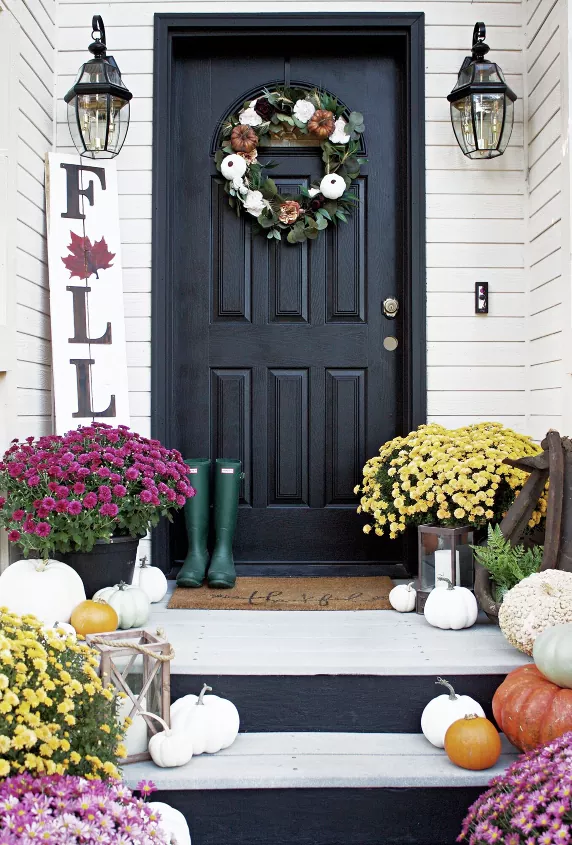


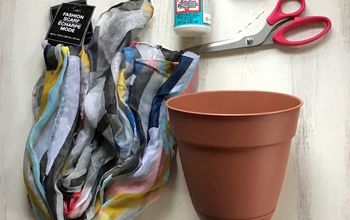
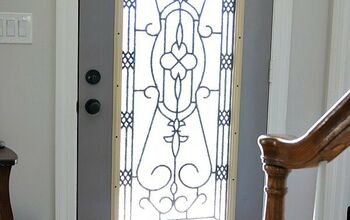
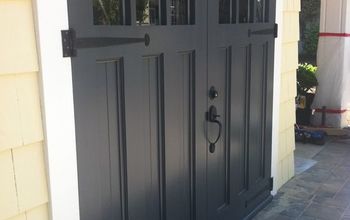


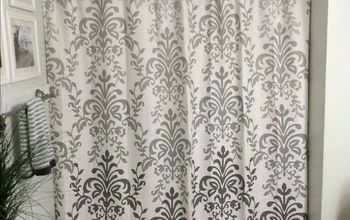

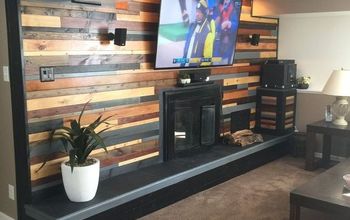









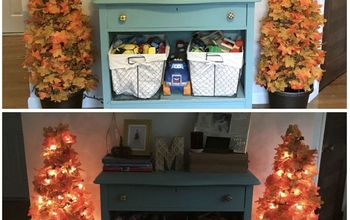

Frequently asked questions
Have a question about this project?